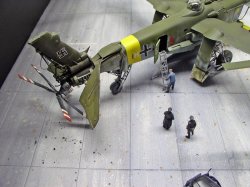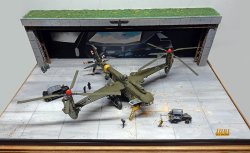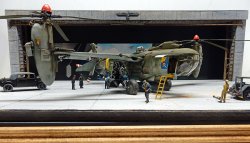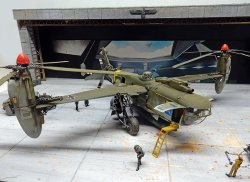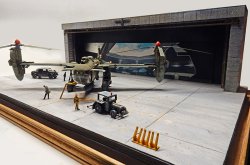
Dorthmund III
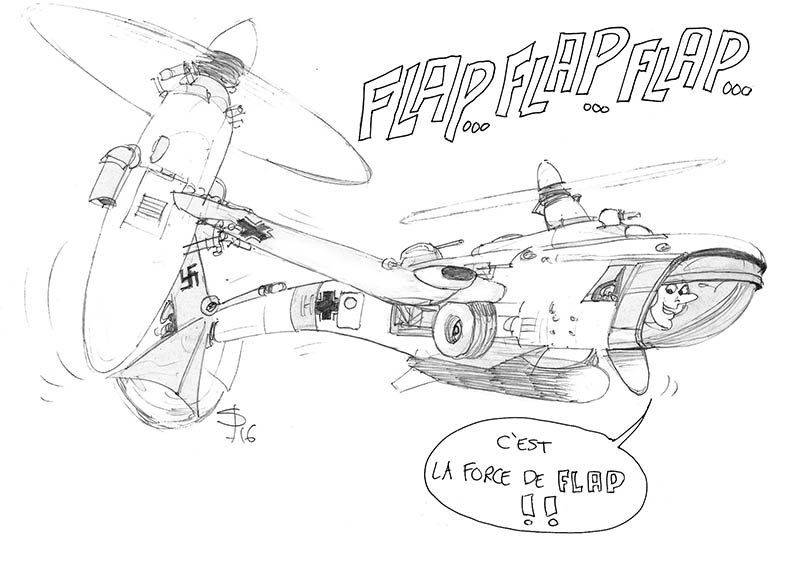
Historique
Les besoins d'un aéronef à la fois mi-avion, mi-hélicoptère se faisant sentir au sein de l'O.K.L. (OberKommando Der Luftwaffe) - disposant de puissance, rapidité et pouvant intervenir n'importe où...
L'Oberstgruppenführer Schmit convoqua le docteur Ferdinand Lippisch - qui avait réussi avec succès le lancement du Fledermaus - afin d'activer la réalisation d'un premier prototype. La guerre en Silésie Orientale "s'étirant" depuis trop longtemps. Le ravitaillement des troupes sur le front posait problème... Hitler, bien que peu intéressé par la technique moderne, et ne jurant que dans l'armement classique, avait donné son accord...
Développé par l'ingénieur Heinrich Dorthmund en 1946, et succèdant au "Dorthmund II" qui se crasha sur l'aire d'essai, tuant le pilote. Après le succès du premier prototype, le modèle "II" montra ses limites par une sous-motorisation et un problème de portance.
Le" III" bénéficia de deux nouveaux moteurs Maybach et d'un empennage plus développé. Le rotor arrière passa de trois pales à cinq. La voilure arrière, gyro-stabilisée, couplée au rotor, devait permettre une fluidité bien meilleure lors du passage du vol vertical en vol horizontal et... réciproquement.
Les roues de grande taille, tous-terrains, ainsi que les nouveaux amortisseurs Armsthrum à grand débattement - se repliant sous les ailes lors du vol - devaient grandement contribuer à améliorer les atterrissages en zones accidentées...
L'équipage comprenait quatre hommes. Un pilote, un navigateur, un manipulateur et un servant à la mitrailleuse de tourelle. La tourelle dorsale était armée de deux MG 313 de 14,5mm assurant la protection ainsi qu'une seconde mitrailleuse binôme de 7,65mm télécommandée pouvant être aussi bien manoeuvrée par le mitrailleur que par le navigateur...
Long de 18 m, d'une envergure - hors pales - de 22,10 m sa vitesse pouvait avoisiner les 650 km/heure grâce à ses deux moteurs développant 700 cv...
Surnommé "Dhort" ou "Maikä" (pour Maikäfer - hanneton en allemand - les portes ouvertes du cockpit à l'horizontal rappelant les antennes de l'insecte) par les équipages. D'une grande mobilité malgré son envergure imposante, la conduite de l'appareil s'avéra d'une grande souplesse et d'une bonne maniabilité malgré ses 28 tonnes. Puissance au décollage et vitesse de pointe assurent une intervention sur site et un dégagement rapide (à l'instar des raids effectués par les "Hueys" américains lors de la future guerre du Vietnam)...
L'appareil transporte en version navale une torpille de 1 000 kg électronique à tête chercheuse, capable, une fois éjectée, d'être autonome sur des kilomètres jusqu'à sa cible. Un missile de croisière est utilisé dans les autres armes. Mais il peut aussi transporter des conteneurs et diverses charges...
En 1948, 2 315 exemplaires furent construits, opérationnels sur tous les fronts. Quelques-uns ont été affectés à la protection civile...
History
The need was felt within the O.K.L. (OberKommando Der Luftwaffe) for an aircraft that was part plane, part helicopter - powerful, fast and able to operate anywhere...
Oberstgruppenführer Schmit summoned Dr. Ferdinand Lippisch - who had successfully launched the Fledermaus - to speed up the production of a first prototype. The war in Eastern Silesia had "dragged on" for too long. Supplying the troops at the front was a problem... Hitler, who had little interest in modern technology and swore by conventional weaponry, agreed...
Developed by engineer Heinrich Dorthmund in 1946, and the successor to the "Dorthmund II", which crashed on the proving ground, killing the pilot. After the success of the first prototype, the "II" model showed its limitations in terms of underpowering and lift.
The "III" benefited from two new Maybach engines and a more advanced tailplane. The rear rotor was increased from three to five blades. The gyro-stabilized rear wing, coupled to the rotor, was intended to provide a much smoother transition from vertical to horizontal flight and... and vice versa.
Large, all-terrain wheels and new Armsthrum long-travel shock absorbers - which fold under the wings during flight - were to contribute greatly to improved landings in rough terrain...
The crew comprised four men. A pilot, a navigator, a manipulator and a turret gunner. The dorsal turret was armed with two 14.5mm MG 313s for protection, as well as a second, remote-controlled 7.65mm binomial machine gun that could be operated by the gunner as well as the navigator...
18 m long, with a wingspan - excluding blades - of 22.10 m, it could reach speeds of up to 650 km/h thanks to its two 700 hp engines...
Nicknamed "Dhort" or "Maikä" (for Maikäfer - German for cockchafer - the open horizontal cockpit doors are reminiscent of the insect's antennae) by crews. Highly mobile despite its imposing wingspan, the aircraft proved to be extremely smooth and maneuverable despite its 28-ton weight. Powerful take-off and top speed ensure rapid intervention on site and rapid clearance (like the raids carried out by the American "Hueys" during the future Vietnam War)...
The naval version of the aircraft carries a 1,000 kg electronic homing torpedo which, once ejected, is capable of flying autonomously for kilometers to its target. A cruise missile is used in other weapons. But it can also carry containers and other loads...
In 1948, 2,315 examples were built, operational on all fronts. Some were assigned to civil protection...















